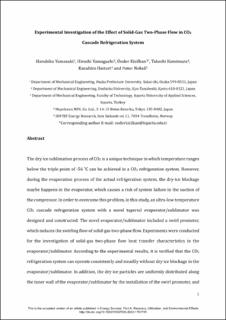| dc.contributor.author | Yamasaki, Haruhiko | |
| dc.contributor.author | Yamaguchi, Hiroshi | |
| dc.contributor.author | Kizilkan, Ônder | |
| dc.contributor.author | Kamimura, Takeshi | |
| dc.contributor.author | Hattori, Kazuhiro | |
| dc.contributor.author | Nekså, Petter | |
| dc.date.accessioned | 2021-07-14T09:52:02Z | |
| dc.date.available | 2021-07-14T09:52:02Z | |
| dc.date.created | 2020-06-15T11:40:15Z | |
| dc.date.issued | 2020 | |
| dc.identifier.issn | 1556-7036 | |
| dc.identifier.uri | https://hdl.handle.net/11250/2764370 | |
| dc.description.abstract | The dry ice sublimation process of CO2 is a unique technique in which temperature ranges below the triple point of −56 °C can be achieved in a CO2 refrigeration system. However, during the evaporation process of the actual refrigeration system, the dry-ice blockage maybe happens in the evaporator, which causes a risk of system failure in the suction of the compressor. In order to overcome this problem, in this study, an ultra-low temperature CO2 cascade refrigeration system with a novel tapered evaporator/sublimator was designed and constructed. The novel evaporator/sublimator included a swirl promoter, which induces the swirling flow of solid-gas two-phase flow. Experiments were conducted for the investigation of solid-gas two-phase flow heat transfer characteristics in the evaporator/sublimator. According to the experimental results, it is verified that the CO2 refrigeration system can operate consistently and steadily without dry ice blockage in the evaporator/sublimator. In addition, the dry ice particles are uniformly distributed along the inner wall of the evaporator/sublimator by the installation of the swirl promoter, and the heat transfer coefficient is considerably improved. © 2020, © 2020 Taylor & Francis Group, LLC | en_US |
| dc.language.iso | eng | en_US |
| dc.publisher | Taylor & Francis | en_US |
| dc.rights | Attribution-NonCommercial-NoDerivatives 4.0 Internasjonal | * |
| dc.rights.uri | http://creativecommons.org/licenses/by-nc-nd/4.0/deed.no | * |
| dc.title | Experimental investigation of the effect of solid-gas two-phase flow in CO2 cascade refrigeration system | en_US |
| dc.type | Peer reviewed | en_US |
| dc.type | Journal article | en_US |
| dc.description.version | acceptedVersion | en_US |
| dc.source.journal | Energy Sources, Part A: Recovery, Utilization, and Environmental Effects | en_US |
| dc.identifier.doi | 10.1080/15567036.2020.1767731 | |
| dc.identifier.cristin | 1815475 | |
| dc.relation.project | Norges forskningsråd: 257632 | en_US |
| cristin.ispublished | true | |
| cristin.fulltext | original | |
| cristin.fulltext | postprint | |
| cristin.qualitycode | 1 | |

